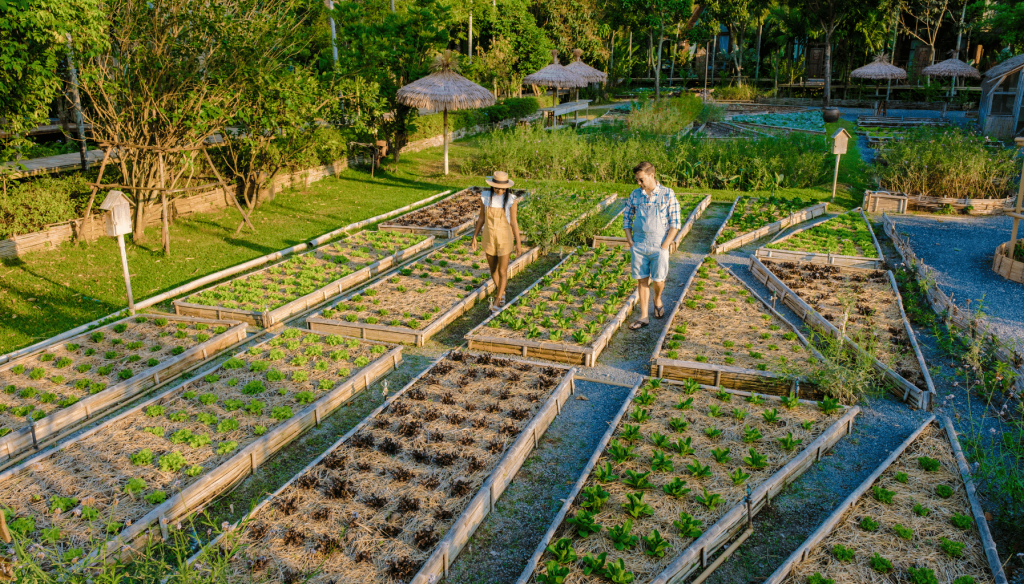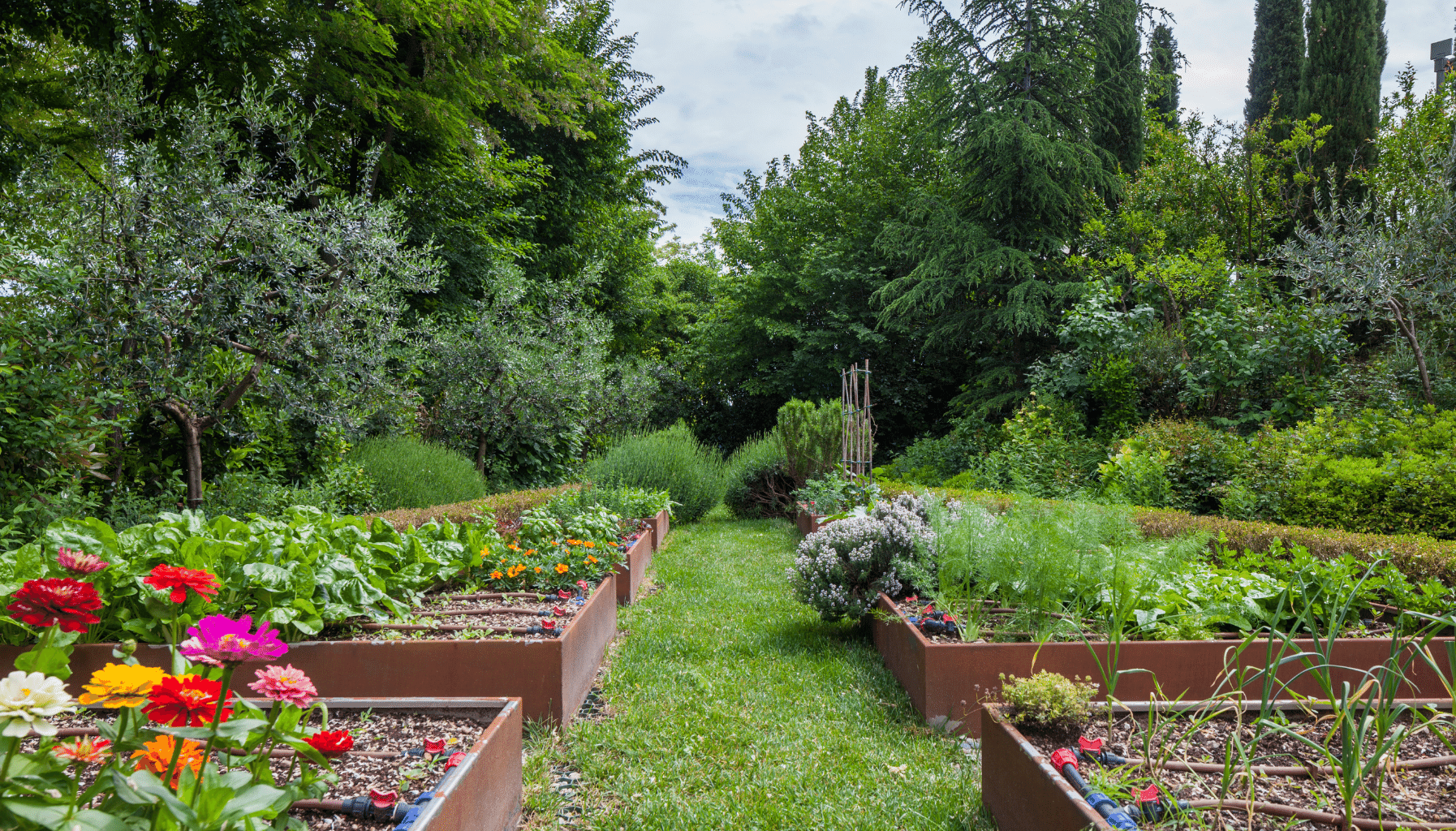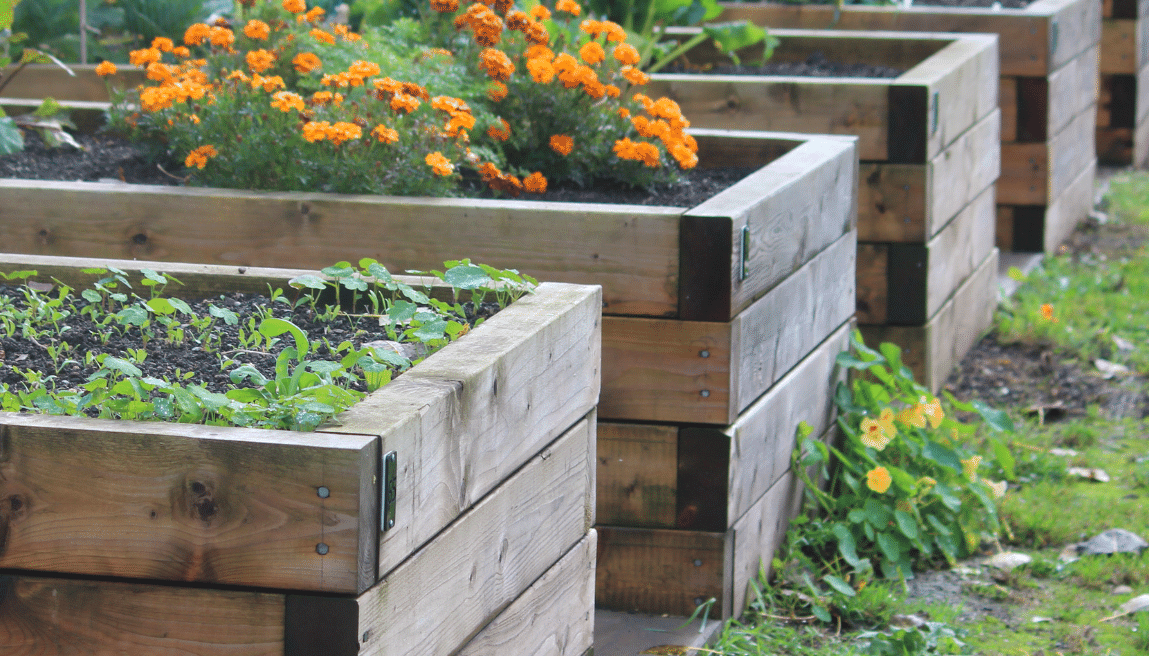
Exploring the world of sustainable gardening opens up many creative opportunities, mainly when designing layouts for raised garden beds. These unique structures address space constraints effectively and improve soil quality and drainage, leading to healthier plant growth.
By carefully planning the layout of your raised garden bed, you can make the most of your available space and create a visually appealing, functional, and sustainable garden.
Incorporating innovative ideas into your design can enhance the overall aesthetics of your garden, making it a beautiful and productive space.
Focusing on sustainability principles such as water conservation and organic gardening practices, you can construct a raised garden bed that will thrive for years.
Innovative Garden Layouts For Sustainable Raised Beds
Exploring imaginative designs and arrangements for elevated planters that encourage sustainability is a fundamental aspect of eco-conscious gardening. Materials like cedar are frequently chosen for their durability and environmentally friendly attributes when constructing raised garden beds.
These raised beds help to improve drainage and facilitate weed management, establishing a more conducive environment for plant growth.
Companion planting strategies in raised beds can enhance sustainability by harnessing natural plant partnerships.
For individuals seeking to optimize their gardening space, raised beds offer a solution that surpasses traditional in-ground methods. Sustainable raised bed gardens can flourish through meticulous planning and upkeep and yield plentiful harvests.

Maximizing Garden Space With Raised Beds
Maximizing the potential of your garden space through innovative raised bed solutions can revolutionize your gardening experience. Utilizing raised beds offers many advantages, including enhanced drainage and soil aeration, less compacted soil, and increased warmth for early spring planting.
When determining the ideal placement for your raised beds, factors such as sunlight exposure, water drainage, and ease of maintenance should all be considered.
Choosing suitable materials, such as untreated wood and quality soil mix, is crucial for the success of your garden soil.
Strategic design elements like trellises, interplanting compatible crops, and rotating crops can further optimize your garden’s productivity. Routine upkeep tasks like watering, mulching, and pest control are essential for the health and longevity of your raised bed vegetable garden. By following these strategies and incorporating raised beds into your gardening practices, you can create a flourishing oasis in your garden soil, use raised beds, organic matter, build your raised bed, fill your raised bed, bed size, fill your raised, vegetable garden, new raised bed, soil depth, feet wide.
Benefits of Utilizing Raised Beds in Your Garden
- Enhanced drainage and soil aeration
- Less compacted soil
- Increased warmth for early spring planting
Building A Raised Garden Bed For Beginners
A raised garden bed can provide a beautiful and functional space for growing fruits, vegetables, and herbs. This step-by-step guide will walk beginners through constructing a raised garden bed, from choosing the right location to preparing the soil mix and filling the bed with the necessary materials.
Whether you have limited space in your backyard or poor soil quality, a raised garden bed can be a practical solution for creating your kitchen garden.
Following these tips and instructions, you can build and maintain a raised garden bed to enjoy a bountiful harvest.
Essential Tips For Building Raised Garden Beds
Several key factors must be considered for a successful build when constructing raised garden beds.
Choosing the right location for your side of the bed is crucial. Ensure it gets enough sunlight and is easily accessible from all sides.
Consider using quality materials such as cedar or redwood for your DIY raised bed to ensure longevity.
Address drainage needs by adding gravel or rocks to the bottom of your raised bed to prevent waterlogging.
When determining the ideal garden design, be mindful of the necessary soil depth – aim for at least 12 inches for healthy plants in a raised bed.
Optimizing plant placement in your raised bed design can maximize space and sunlight for each variety.
Consistent watering is essential to keeping your plants thriving in the ideal raised bed environment. To protect against pests, add organic pest control methods to your raised bed garden design.
Critical Factors for Successful Raised Garden Beds
- Choosing the right location with adequate sunlight and accessibility is crucial for plant growth.
- Using quality materials like cedar or redwood ensures the longevity of your DIY raised bed.
- Addressing drainage needs by adding gravel or rocks prevents waterlogging and promotes healthy plant growth.
- Optimizing plant placement maximizes space and sunlight, creating a more productive garden.
Creating A Sustainable Garden Design With Raised Beds
When designing a garden space with elevated planting areas, raised beds offer a versatile solution for cultivating a sustainable and eco-friendly environment. Raised beds allow the layout to be customized to meet specific gardening needs, whether for growing herbs, vegetables, or other plants.
The elevated structure of the raised bed allows for better control over soil quality, drainage, and aeration, ensuring optimal conditions for plant growth.
One raised bed can be dedicated to herbs, while another can hold your favorite vegetables.
Raised beds offer benefits such as improved drainage and soil aeration, making gardening in them a breeze. They also prevent soil compaction, allowing plant roots to grow freely.
Raised beds allow for better control over plant spacing and layout, maximizing the use of your garden planner.
Consider using eco-friendly materials like reclaimed wood or recycled plastic when constructing a raised bed.
The Benefits Of Using Raised Beds In Your Garden
Raised garden beds provide numerous advantages for cultivating plants, fostering ideal conditions for plant growth. These elevated garden setups facilitate improved drainage, prevent soil compaction, and enhance soil quality.
Local gardening enthusiasts or those embarking on DIY raised bed projects can benefit from the versatility of raised beds.
Adjusting the height of your raised garden bed allows for customizability to suit your specific gardening needs.
You can ensure longevity and create optimal plant growth conditions by selecting quality materials like cedar for your raised bed. Consider the advantages of incorporating raised beds into your gardening practices for a thriving garden.
Benefits of Raised Garden Beds
- Improved drainage in raised garden beds helps prevent waterlogging and root rot.
- Preventing soil compaction in raised beds improves root development and nutrient absorption.
- Enhanced soil quality in raised garden beds promotes healthy plant growth and productivity.
- Customizable height options for raised beds cater to different gardening needs and preferences.
Maximizing Soil Health In Raised Garden Beds
Focus on soil vitality to enhance the productivity of your raised garden beds. The success of gardening hinges on the quality of the soil utilized.
Whether you have prior experience with raised bed gardening or are just beginning, selecting the correct soil mix is paramount.
Adding organic matter to your raised beds can improve fertility and support robust plant growth.
Consider integrating cover crops to enhance soil structure and prevent erosion. Practicing crop rotation can mitigate nutrient depletion and uphold soil health for optimal plant development.
Remember to routinely test your soil and maintain balanced pH levels for optimal outcomes.
Designing A Beautiful And Functional Raised Garden Bed
Elevating your outdoor space with a stunning new garden feature involves more than just planting flowers and shrubs. When designing a beautiful and functional raised garden bed, there are crucial elements to consider that go beyond the aesthetics.
Choosing materials wisely is essential for durability and visual appeal and ensuring that the bed fits seamlessly into your current garden layout.
Incorporating practical features like watering systems and trellises can enhance the bed’s usability and add a touch of elegance to the overall design.
Maximizing space efficiency is crucial for promoting healthy plant growth and easy maintenance, making it easier to keep your garden looking its best all year round. By following these expert tips, you can create a raised bed space that not only enhances the beauty of your garden but also provides a practical and functional centerpiece for your outdoor oasis. Be sure to visit our website for a guide to building raised beds for your new garden.
Raised Garden Beds Unveiling The Space Saving Wonders For Small Spaces
Eco Friendly Raised Garden Bed Layouts Inspiration



